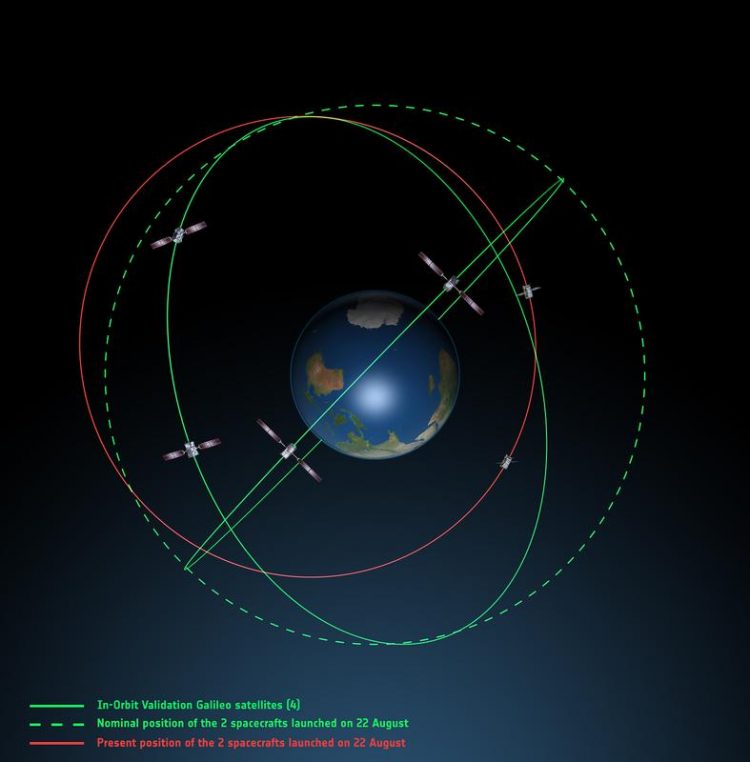Errant Galileo satellites will be used for research on Einstein’s general theory of relativity

Orbits of the Galileo satellites ESA
“Milena“ and ”Doresa“ were designed to orbit the Earth at a constant height of 23,000 kilometers to deliver precise navigation data for Galileo, the European alternative to the GPS system. However, a frozen fuel line on the launch vehicle caused the satellites to be marooned in an elliptical orbit.
Consequently, their height above the Earth varies continuously between 17,500 and 25,000 kilometers. These fluctuations in height leave them unable to perform their intended task but ideal for the investigation of gravitational red shift, which is one of the central predictions of the general theory of relativity established by Albert Einstein 100 years ago.
This prediction states that gravity – in this case the gravitational force of the Earth – influences time. For example, a clock placed at the top of a tower will run faster than a clock placed at the bottom due to the lower gravitational force it experiences.
The experiment providing the most precise data so far for the proof of the gravitational red shift took place in 1978. Two identical clocks were placed at a distance of 10,000 kilometers – one on Earth and one on a rocket.
In contrast to this one‐off experiment the Galileo satellites change their height by almost 8,000 kilometers twice a day, providing an enormous amount of data. Compared to the experiment in 1978, Laemmerzahl is expecting to show the effect of red shift with 10 times the precision and without the high costs associated with the design of a new research mission.
Contact person for scientific questions:
Prof. Dr. Claus Laemmerzahl
0421 218-57834
claus.laemmerzahl@zarm.uni-bremen.de
Contact person for general press inquiries:
Birgit Kinkeldey
+49 421 218-57755
birgit.kinkeldey@zarm.uni-bremen.de
Photo material concerning the topic can be found under the following link: https://www.zarm.uni-bremen.de/pressmedia/single-view/article/errant-galileo-sat…
Media Contact
All latest news from the category: Earth Sciences
Earth Sciences (also referred to as Geosciences), which deals with basic issues surrounding our planet, plays a vital role in the area of energy and raw materials supply.
Earth Sciences comprises subjects such as geology, geography, geological informatics, paleontology, mineralogy, petrography, crystallography, geophysics, geodesy, glaciology, cartography, photogrammetry, meteorology and seismology, early-warning systems, earthquake research and polar research.
Newest articles

Ion thermoelectric conversion devices for near room temperature
The electrode sheet of the thermoelectric device consists of ionic hydrogel, which is sandwiched between the electrodes to form, and the Prussian blue on the electrode undergoes a redox reaction…

Zap Energy achieves 37-million-degree temperatures in a compact device
New publication reports record electron temperatures for a small-scale, sheared-flow-stabilized Z-pinch fusion device. In the nine decades since humans first produced fusion reactions, only a few fusion technologies have demonstrated…

Innovative microscopy demystifies metabolism of Alzheimer’s
Researchers at UC San Diego have deployed state-of-the art imaging techniques to discover the metabolism driving Alzheimer’s disease; results suggest new treatment strategies. Alzheimer’s disease causes significant problems with memory,…





















